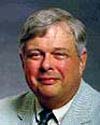Carl M. Bender and Thomas A. Woolsey have been awarded fellowships from the John Simon Guggenheim Memorial Foundation.
Bender, Ph.D., is professor of physics in Arts & Sciences. Woolsey, M.D., is the George H. and Ethel R. Bishop Scholar in Neuroscience and professor of neurology, of neurological surgery, of anatomy and neurobiology, and of cell biology and physiology, all in the School of Medicine. He also is professor of biomedical engineering in the School of Engineering & Applied Science.

Bender will be on sabbatical at Imperial College in London for his fellowship period, which runs from June 2003-May 2004. There he will conduct a research project titled “A New Approach to Quantum Field Theory.”
Of the 184 Guggenheim fellowships awarded this year, only four were given in the area of physics.
Bender works primarily in quantum mechanics, the physics of very small, submicroscopic or atomic particles, and in particle physics and quantum field theory. Quantum mechanics underlies nearly all modern science and technology; it governs the essential components of computers and televisions and serves as a basis for chemistry.
In London, Bender will work on a new area of theoretical physics that he originated four years ago, namely, the extension of conventional quantum mechanics and quantum field theory into the complex plane.
“Complex quantum mechanics is not just a mathematical breakthrough,” Bender said. “I believe it to be a major advance in the basic theory of quantum mechanics.
“The potential for research in this area is immense: Complex quantum mechanics provides a framework for describing the nature of antiparticles. It offers the possibility that a particle and its corresponding antiparticle need not have identical masses, and thus it may provide insight into the puzzle of why there is so much more matter than antimatter in the universe.
“Moreover, complex quantum mechanics gives a setting for exploring the physics of the Higgs particle, which is the as-yet unobserved and most poorly understood component of modern particle physics,” Bender added.
Bender has been invited to lecture on his work at more than a dozen universities in Europe during his fellowship year. He will also present invited talks at many international conferences on theoretical physics, including giving the keynote address at a conference in Prague, Czech Republic, that is devoted entirely to the field of complex quantum mechanics that he originated.
A Phi Beta Kappa, Bender earned a bachelor’s degree, summa cum laude, in physics from Cornell University in 1964 and both a master’s (1965) and doctorate (1969) in physics from Harvard University. After seven years on the Massachusetts Institute of Technology faculty, he joined Washington University’s Department of Physics in 1977.

Woolsey’s fellowship is based on his proposal to compile a “living work” for researchers studying the brain.
By examining slices of mouse and rat brains, Woolsey discovered a body map lying parallel to the brain’s surface. Nerve cells in this body map are arranged into varying configurations, each representing a different body part.
By organizing published information and commentaries related to this body map online, Woolsey hopes to facilitate scientific collaborations and discoveries.
“A lot of researchers are investigating this part of the brain,” Woolsey said. “They use the context the body map provides to help understand how the brain develops and functions as well as to understand the role of genes in these processes.
“This planned work should allow researchers from different parts of the world to compare their findings and evaluate new information directly. I think it’s extremely interesting to consider different perspectives on scientific issues and to think about how to put all of them together cogently.”
Woolsey has been recognized for his research, teaching and service by various other awards and honors, including the Cortical Discoverer Award from the American Association of Anatomists (2002), the Javits Neuroscience Investigator Award from the National Institutes of Health (1993) and Teacher of the Year, Senior Class Award from the School of Medicine (1992).
He was elected a fellow of the American Association for the Advancement of Science (2000) and has been president of the St. Louis Academy of Science since 1998.
Woolsey earned a bachelor’s degree from the University of Wisconsin in 1965 and a medical degree from Johns Hopkins University in 1969. He came to Washington University as a surgical intern in 1969 and joined the faculty in 1971.